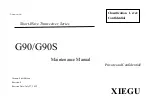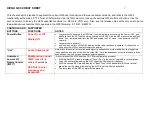
HN-291D
Guidelines for Reducing Interference
Introduction
The transceivers share the same frequency spectrum with other services and other
Part 15 devices in the US. Because of this, you may not achieve 100 percent of rated
throughput in a given location due to retransmissions. However, you should not
experience any data loss or erroneous data. The flexible design of the radio and the
hopping pattern should allow for adequate performance as long as care is taken in
choosing station location, configuration parameters of the transceivers, and protocols
techniques.
Use the following guidelines to reduce interference in your HopNet system.
Guidelines for Setting Up the Network
In general, the following points should be followed when setting up a network:
Systems installed in rural areas are least likely to encounter interference.
If possible, use directional antennas at remote sites. The directional antennas confine
the transmission path and reception pattern to a comparatively narrow lobe, which
minimizes interference from stations located outside the pattern.
Multiple HopNet systems can co-exist in close proximity to each other with very
minor interface as long as they are assigned a unique network address. Each network
address has a different hop pattern.
If interference is suspected from a similar operating system, change the antenna
polarization. This will provide an additional 20dB of attenuation to interference.
For indoor applications, set all transceivers for the lowest level necessary for reliable
communications. This lessens the chance of interference from nearby systems.
Guidelines for Selecting Your Site
Use these guidelines to select a proper site for the master remote stations. Suitable
sites should provide the following:
•
An adequate and stable source of primary power.
•
Antenna location that provides an unobstructed transmission path in the
direction of the associated units.
•
Proper antenna selection, data access, and feedline cabling
•
A clear line-of-sight. Microwave radio signals travel primarily by line-of-
sight, and obstructions between the sending and receiving stations will affect
system performance.
•
Aiming the antenna — Use the sticker on the remote unit to help you locate
and aim the antenna. The sticker indicates which direction the antenna is
pointing.
©
2000- 2004 Cirronet
™
Inc
45
M-0910-0002 Rev B







































